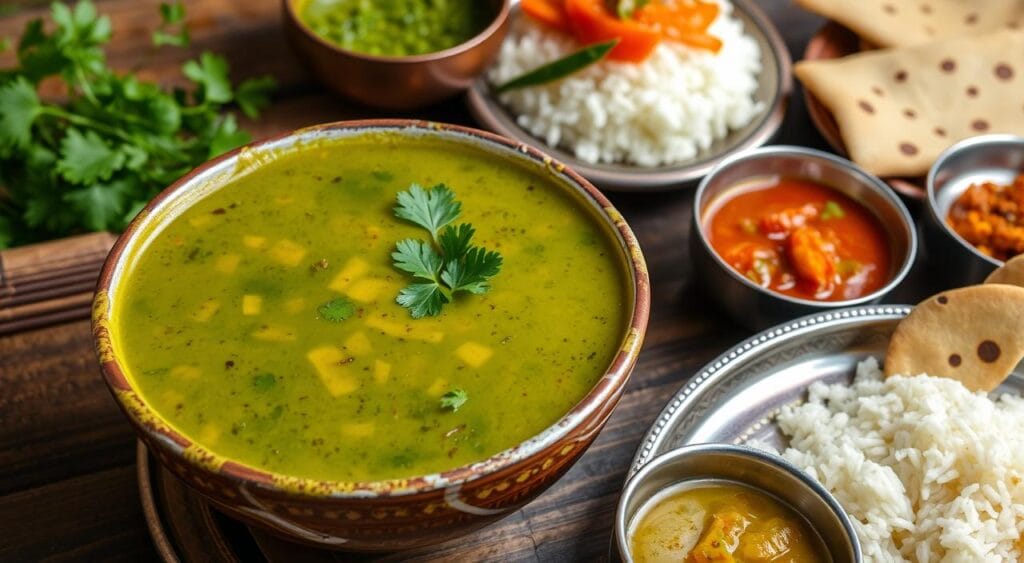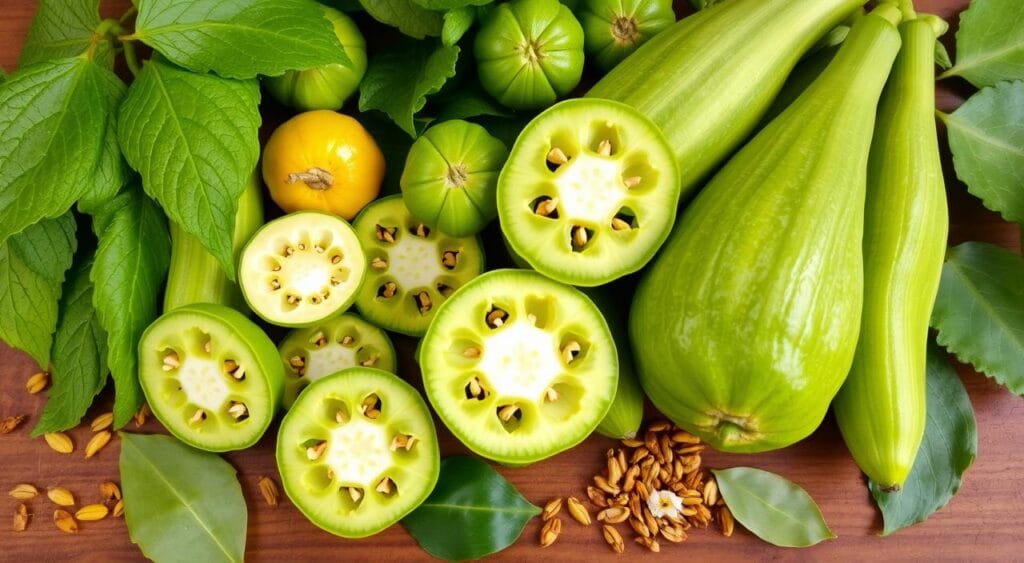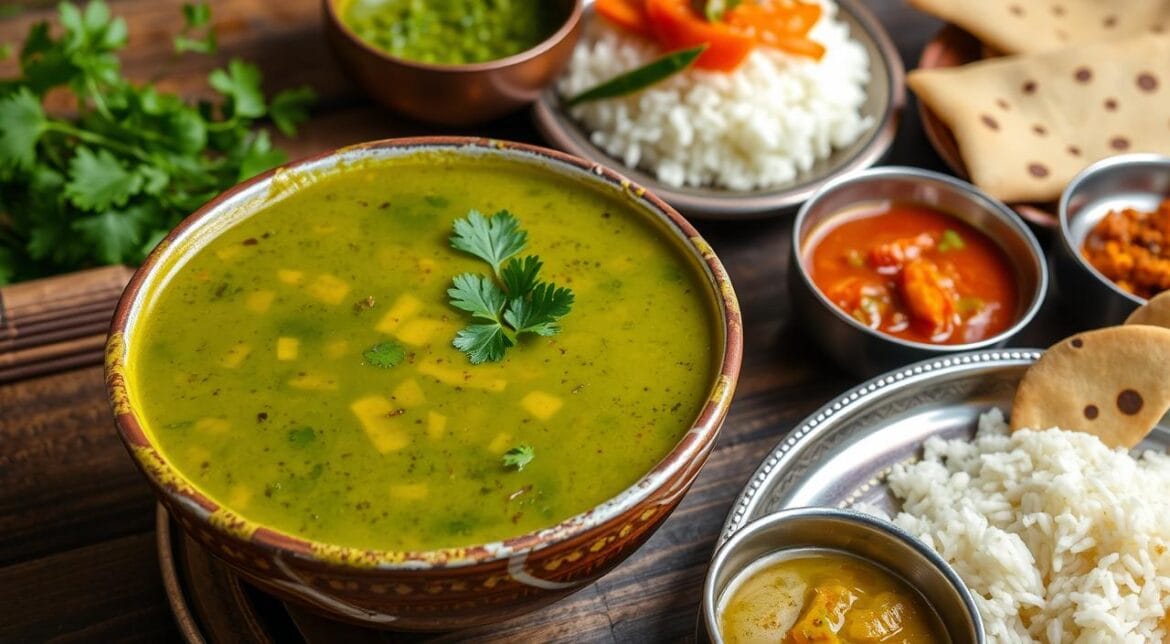Table of Contents
Explore the vibrant flavors of South Indian cuisine with our authentic recipe for fresh green sundakkai sambar. This beloved vegetarian dish uses sundakkai, also known as turkey berry or garden egg. It adds a unique and delightful taste to the dish.
In this guide, we’ll dive into sundakkai’s rich culinary heritage and its health benefits. We’ll also show you how to make the perfect fresh green sundakkai sambar in your kitchen.

Key Takeaways
- Discover the culinary significance of fresh green sundakkai in South Indian cuisine.
- Learn the health benefits and nutritional value of this versatile vegetable.
- Understand the essential ingredients and preparation techniques for an authentic sambar.
- Explore traditional and modern cooking methods to master the art of sambar preparation.
- Avoid common mistakes and learn serving suggestions to elevate your sundakkai sambar experience.
Understanding Green Sundakkai and Its Culinary Significance
Green sundakkai, also known as turkey berries, are a unique ingredient in South Indian cuisine. They are small, tart, and have long been valued for their taste and health benefits.
Traditional Uses in South Indian Cuisine
In South Indian cooking, green sundakkai add a unique tartness and aroma. They are used in sambar, a lentil-based stew, and in poriyal (dry vegetable preparations). They also feature in rasam (tangy soup) and as a simple side dish with spices.
Health Benefits and Nutritional Value
Green sundakkai are packed with nutrients, making them great for your diet. They are rich in vitamins A, C, and K, and minerals like iron, calcium, and potassium. They also have high antioxidants, which boost well-being and immune function.
Different Varieties of Sundakkai
- Green Sundakkai: The most common variety, with a tart, slightly bitter flavor.
- Purple Sundakkai: A rarer type with a deeper hue and a slightly sweeter taste.
- Sundakkai Vatral: Sun-dried and preserved sundakkai, often used to add a distinctive tang to dishes.
Each variety of sundakkai adds a unique twist to sundakkai recipes. They offer a special culinary experience that celebrates the authentic flavors of South Indian cuisine.

Essential Ingredients for Fresh Green Sundakkai Sambar
Making a true fresh green sundakkai sambar is all about picking the right ingredients. This dish, loved in South Indian cuisine, mixes lentils, spices, and veggies. Each one is key to its unique flavor.
The fresh green sundakai, or turkey berries, are at the heart of the sambar. They add a tangy taste and a crunchy feel. This makes them a perfect match for the other ingredients.
- Fresh green sundakai (turkey berries)
- Toor dal (pigeon peas)
- Tamarind paste
- Coriander powder
- Cumin powder
- Turmeric powder
- Asafoetida (hing)
- Mustard seeds
- Curry leaves
- Onion
- Tomato
- Garlic
- Red chili pepper
- Salt to taste
Every ingredient in this list is important for the sambar’s taste and texture. From the toor dal to the spices, they all work together. This creates a memorable taste experience.
“The secret to a perfect fresh green sundakkai sambar lies in the balance of its ingredients, each one contributing its unique essence to the final dish.”
Kitchen Tools and Equipment Required
To make authentic south Indian dishes like sundakkai sambar, you need the right tools. Whether you use old methods or new gadgets, the right setup is key. It helps you get the rich, flavorful taste you want.
Traditional vs Modern Cooking Tools
Traditionally, sundakkai sambar is made with ancient tools. But today, modern appliances offer quicker ways to cook. For example, mortars and pestles have been used for ages to grind spices. Yet, blenders can do the job faster and more efficiently.
Preparation Equipment Checklist
- Heavy-bottomed pot or saucepan
- Ladle for stirring and serving
- Cutting board and sharp knife
- Mixing bowls of various sizes
- Measuring cups and spoons
- Strainer or colander
- Blender or food processor (for modern approach)
- Mortar and pestle (for traditional approach)
Having the right tools is crucial, whether you like old ways or new gadgets. With the right tools, you can make a delicious south Indian sundakkai sambar at home.
| Traditional Cooking Tools | Modern Cooking Appliances |
|---|---|
| Mortar and pestle | High-speed blender |
| Clay pot or thick-bottomed pan | Electric pressure cooker |
| Wooden ladle | Food processor |
| Grinding stone | Electric spice grinder |
Preparing Fresh Green Sundakkai for Cooking
Fresh green sundakkai, also known as fresh green brinjals, are key for a tasty sundakkai sambar. It’s important to prepare them well for the best taste and texture. Let’s look at how to get your sundakkai ready for delicious sundakkai recipes and fresn green sundakai sambar.
Start by washing the sundakkai under running water. This removes dirt and debris. Next, gently pat them dry using a clean towel or paper towels.
Check each sundakkai for any bad spots and cut them off with a knife. This step is crucial to avoid bitterness in your dish.
- If the sundakkai have thick, tough skins, peel them lightly with a vegetable peeler for a smoother texture.
- Some sundakkai are a bit bitter. Soaking them in salted water for 15-20 minutes can help reduce this bitterness.
After cleaning and prepping, your sundakkai are ready for your favorite sundakkai recipes, like the classic fresn green sundakai sambar. Proper preparation makes a big difference in your dish’s flavor and quality.
“The key to making an exceptional sundakkai sambar lies in the quality and proper preparation of fresh green sundakkai.”
Making the Perfect Sambar Base
Making the perfect sambar base is key to a true south indian cuisine dish. It’s a flavorful vegetarian dish that needs a mix of spices and toor dal.
Spice Blend Proportions
The spice blend is the heart of the sambar base. To get the right flavor, use these spice amounts:
- Coriander seeds: 2 parts
- Cumin seeds: 1 part
- Fenugreek seeds: 1/2 part
- Dry red chili peppers: 1 part
- Black peppercorns: 1/4 part
Toor Dal Preparation Tips
Toor dal, or split pigeon peas, is crucial for the sambar base. To get it right, follow these steps:
- Soak the toor dal in water for 30 minutes to an hour before cooking.
- Cook the dal until it’s soft but still has some texture.
- Use a ratio of 1 part toor dal to 3 parts water for the right consistency.
- Add a pinch of turmeric to the cooking water for better color and aroma.
Mastering the spice blend and toor dal preparation will help you make a memorable vegetarian delicacy. It will truly capture the spirit of south indian cuisine.
Step-by-Step Fresh Green Sundakai Sambar Recipe
Learn to make a delicious fresh green sundakai sambar. This South Indian dish is loved for its vibrant flavors and textures. Follow this guide to make a true sundakkai recipes that will excite your taste buds.
Start by getting all the ingredients. You’ll need fresn green sundakai, spices, and lentils. Wash and trim the sundakkai well before cooking.
- Boil water in a large pot and add sundakkai. Simmer for 10-12 minutes until tender.
- Drain the sundakkai and save the cooking liquid.
- Dry-roast spices like cumin, coriander, and red chili until fragrant. Then, grind them into a powder.
- Heat oil in a pan and sauté the spice powder. Let the flavors bloom.
- Add the cooked sundakkai to the oil and stir well.
- Pour in the cooking liquid slowly, adjusting the thickness as needed.
- Simmer the mixture for 15-20 minutes to blend the flavors.
- Season with salt and lemon juice for the final touch.
Enjoy your fresh green sundakai sambar over basmati rice or with papadam. It’s a true South Indian treat.
Savor the essence of South India in every bite of this fresh green sundakai sambar.
Mastering the Authentic Sambar Seasoning
Improving your South Indian dishes starts with making great sambar seasoning. This mix is key to a tasty sambar, bringing out the perfect spice balance. Learning to make sambar seasoning is a journey to truly enjoy authentic flavors in your south indian cuisine.
Traditional Tempering Methods
The traditional way to make sambar seasoning involves a special tempering method. This method heats aromatic seeds, pods, and dried chilies in ghee or oil. It brings out their complex aromas and flavors.
Regional Spice Variations
- Every region in South India has its own sambar seasoning twist, showing local tastes and traditions.
- In Tamil Nadu, sambar often has more black mustard seeds and curry leaves. Andhra Pradesh’s sambar has more red chilies for a spicy taste.
- Trying different spice blends from various regions can add new flavors to your south indian cuisine.
By learning traditional tempering and trying different spice mixes, you can make your sambar seasoning better. This will take your south indian cuisine to new levels of authentic flavors.
Common Mistakes to Avoid While Cooking
Making a tasty sundakkai sambar is rewarding, but mistakes can happen. As you start your sundakkai recipes, watch out for these common errors. This way, your fresh green sundakai sambar will always be perfect.
Overcooking the Sundakkai
One big mistake is overcooking the sundakkai. This makes them mushy and unappealing. Stick to the recipe’s cooking time and check the sundakkai often. Remove them from heat when they’re just right.
Imbalanced Spice Blend
It’s important to get the spice mix right for a true sundakkai sambar taste. Don’t add too much of any spice, as it can overwhelm the dish. Use the recipe’s spice blend carefully for a balanced flavor.
Neglecting the Tempering
The final tempering, or tadka, is key. It adds depth and complexity to the sambar. Don’t skip or hurry this step. It’s what makes the dish complete and enhances its aroma and taste.
| Common Mistake | How to Avoid It |
|---|---|
| Overcooking the sundakkai | Follow the recipe’s cooking time and monitor the sundakkai closely |
| Imbalanced spice blend | Measure and adjust spices carefully according to the recipe |
| Neglecting the tempering | Take the time to properly execute the final tempering step |
By avoiding these common mistakes and following the recipe, you can make a delicious sundakkai sambar. It will impress everyone. Enjoy your sundakkai recipes with confidence!
Serving Suggestions and Accompaniments
There are many ways to serve fresh green sundakkai sambar. This south indian cuisine dish goes well with both traditional and modern sides. It makes any meal special.
Traditional Pairings
In south indian cuisine, sundakkai sambar is often served with classic foods. Here are some favorite pairings:
- Steaming hot rice, either white or fragrant basmati
- Soft, fluffy idli or velvety dosa, perfect for sopping up the savory broth
- Crispy papadum, adding a satisfying crunch to the meal
- Tangy pickles or chutneys, complementing the bold flavors of the vegetarian delicacy
Modern Fusion Options
For a modern twist, sundakkai sambar can be paired in new ways. Here are some ideas:
- Sundakkai sambar-stuffed baked potatoes or sweet potatoes
- Sundakkai sambar-infused quinoa or farro bowls, topped with roasted vegetables
- Sundakkai sambar-marinated tofu or paneer, served with a side of fragrant basmati rice
- Sundakkai sambar-drizzled avocado toast or bruschetta, for a delightful plant-based option
Whether you choose a traditional or modern pairing, sundakkai sambar is a treat. It showcases the lively tastes of south indian cuisine and the flexibility of this vegetarian delicacy.
Storage Tips and Reheating Guidelines
To keep your fresh green sundakai sambar tasty, store it right. Store any leftovers in an airtight container and refrigerate for up to 3 days. This keeps the flavors fresh and prevents spoilage.
When reheating your fresn green sundakai sambar, use a saucepan over medium heat. Stir it occasionally until it is heated thoroughly. Don’t microwave it to avoid texture loss.
For the best taste, reheat it in a covered pot on the stovetop. Add a bit of water or broth if it’s too thick. Follow these tips to enjoy your sundakkai recipes even after the first time you make them.
FAQ
What are the traditional uses of green sundakkai in South Indian cuisine?
Green sundakkai, also known as turkey berries, are a staple in South Indian dishes. They’re used in sambar, kootu, usili, and other vegetable dishes. They add a unique flavor and texture to these regional specialties.
What are the health benefits and nutritional value of green sundakkai?
Green sundakkai are packed with antioxidants, fiber, and vitamins and minerals. They help with digestion, boost the immune system, and support heart health. Adding sundakkai to your diet can be a nutritious choice.
What are the different varieties of sundakkai used in South Indian cuisine?
Sundakkai come in small, round green ones and larger, elongated versions. The choice depends on the region and dish, each offering unique flavors and textures.
What are the essential ingredients needed to make fresh green sundakkai sambar?
To make authentic fresh green sundakkai sambar, you need toor dal, sundakkai, tomatoes, onions, garlic, cumin, coriander, red chili peppers, and tamarind. These ingredients create the distinctive flavor of this South Indian delicacy.
What traditional and modern cooking tools are used to prepare sundakkai sambar?
Traditional kitchens use a mortar and pestle for grinding spices. Modern kitchens might use a high-powered blender or spice grinder. A pressure cooker is common for cooking toor dal and vegetables, but some prefer a saucepan for simmering.
How should fresh green sundakkai be prepared before cooking?
Before cooking, clean, sort, and prepare the sundakkai. Remove any blemished berries, rinse well, and sometimes parboil or sauté to reduce bitterness and enhance flavor.
How do you create the perfect sambar base for fresh green sundakkai sambar?
To make the perfect sambar base, balance spices, toor dal, and other ingredients. Cooking the dal right and blending spices is key for the authentic flavor.
What are some common mistakes to avoid when cooking fresh green sundakkai sambar?
Avoid overcooking sundakkai for a bitter taste, not cooking toor dal enough, and not tempering the sambar right. Focus on cooking times and techniques to avoid these mistakes.
What are some traditional and modern ways to serve fresh green sundakkai sambar?
Serve sundakkai sambar with steamed rice, idli, dosa, and vada. For a modern twist, try it with quinoa, cauliflower rice, or as a dip for vegetable fritters or naan bread.
How should leftover fresh green sundakkai sambar be stored and reheated?
Store leftover sundakkai sambar in an airtight container in the fridge for 3-4 days. Reheat with a splash of water on the stovetop or in the microwave, stirring often. Avoid overcooking to keep the sundakkai from becoming mushy.


3 comments
[…] Jalbitedrinks Liquor Recipe: Step-by-Step Guide How to Make Carnitas Breakfast Burrito: Easy Recipe How to Make Fresh Green Sundakkai Sambar: Authentic… Carrot and Spinach Recipes with Couscous: Delicious and… Banana Brownie Cookies Made Easy How to […]
[…] paruppu usili is a favorite in Tamil cuisine. It mixes the bitterness of fresh green sundakkai with the earthy taste of lentils. This mix of flavors has been loved for many […]
[…] To learn more about the nutritional benefits of Turkey Berry, you can check out this comprehensive Health Benefits of Turkey Berry […]
Comments are closed.